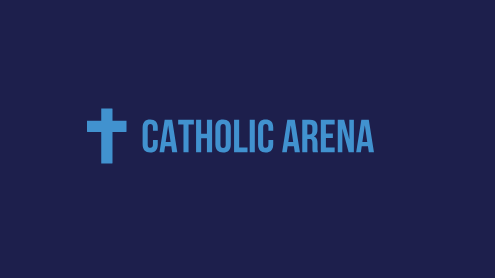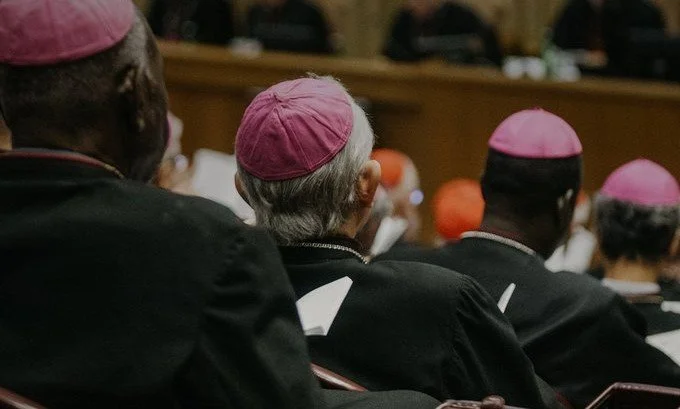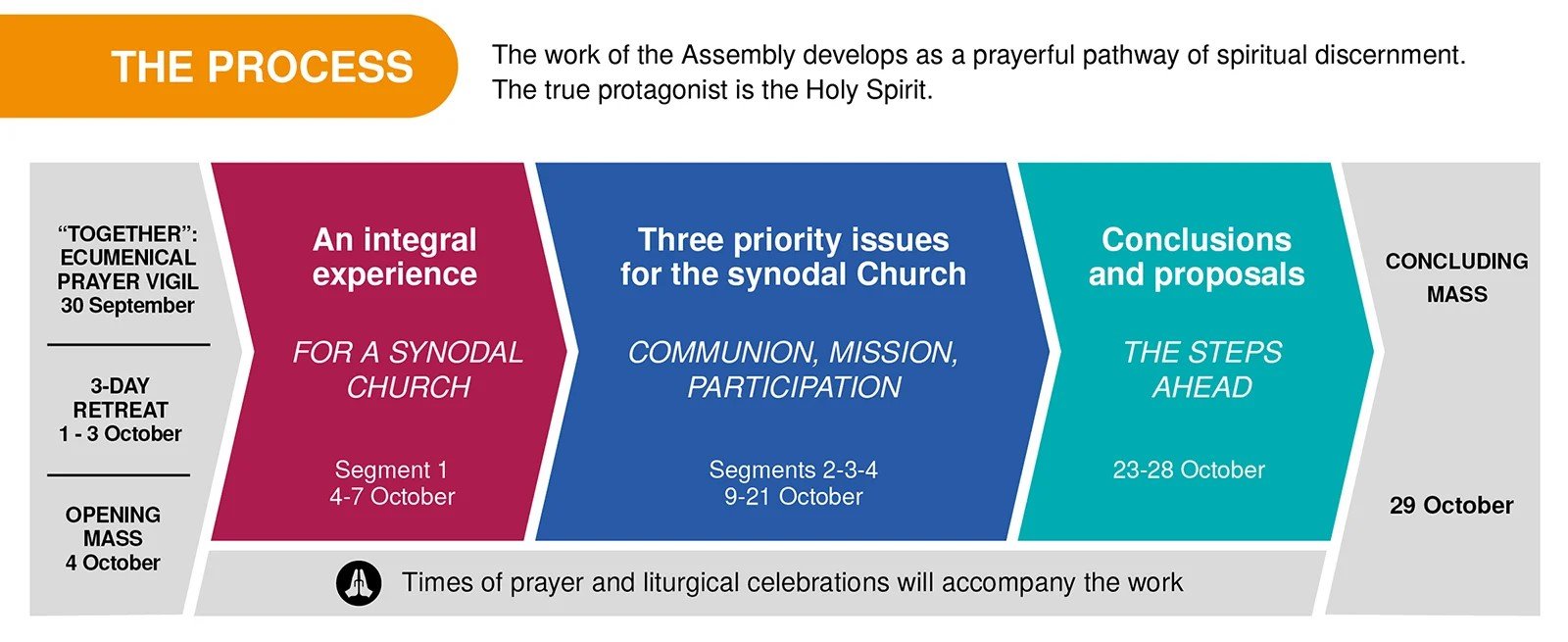Many have heard that the “Synod on Synodality” is starting this week in Rome — but what is a “Synod”? And, more importantly, why should I care?!
Wikipedia defines a SYNOD as:
“A synod is a council of a Christian denomination, usually convened to decide an issue of doctrine, administration or application…Originally, synods were meetings of bishops…In modern usage, the word often refers to the governing body of a particular church, whether its members are meeting or not. It is also sometimes used to refer to a church that is governed by a synod.”
CATHOLIC SYNODS
The word “synod” comes from the Greek synodos, meaning “an assembly.” During Vatican II the term “Synod” was synonymous with “Council” but the term has expanded since then.
Synods meet in different types of Assembly:
In an Ordinary General Assembly, for matters concerning the good of the universal Church;
In an Extraordinary General Assembly, for matters of urgent consideration;
In a Special Assembly, for matters which mostly concern one or more specific geographical regions.
Pope Paul VI instituted the synods of bishops, which comes together at the Pope’s request to guide him about some issue or specific need in the Church. The synod of bishops is a consultative body — the Holy Father makes the final call!
(For example, Pope Francis rejected the recommendation for married priests in the Amazon because: “There was a discussion...a rich discussion...a well-founded discussion, but no discernment, which is something different from arriving at a good and justified consensus or relative majority,” he wrote. “We must understand that the Synod is more than a parliament; and in this specific case it could not escape this dynamic.”)
Under Pope Francis there have been some ‘Extraordinary’ synods — such as synods on The Family; Young People & the Amazon. The Holy Father urges bishops to hold local listening sessions in their dioceses before a Synod and he is inviting more laypeople (both sexes) to participate in the bishops’ meetings in Rome. This is a good thing!
“SYNODALITY IN THE LIFE AND MISSION OF THE CHURCH”
The International Theological Commission undertook a study of synodality in the life and mission of the Church, 2014-2017. After approval by Pope Francis, they published the document titled above. I am appending a few clauses because this explains the thinking which led to this Synod:
“Since the first centuries, the word “synod” has been applied, with a specific meaning, to the ecclesial assemblies convoked on various levels (diocesan, provincial, regional, patriarchal or universal) to discern, by the light of the Word of God and listening to the Holy Spirit, the doctrinal, liturgical, canonical and pastoral questions that arise as time goes by.”
Synods are used to answer a specific question facing the Church. They are advisory, rather than expected to set a specific direction for the Church, or to define Church Law.
“The fruits of the renewal promised by Vatican II in its promotion of ecclesial communion, episcopal collegiality and thinking and acting ‘synodally’ have been rich and precious. There is, however, still a long way to go in the direction mapped out by the Council. In fact, today the drive to find an appropriate form for a synodal Church – although it is widely shared and has been put into practice in positive ways – seems to be in need of clear theological principles and decisive pastoral orientations. Hence the new threshold that Pope Francis invites us to cross. In the wake of Vatican II, following in his predecessors footsteps, he insists that synodality describes the shape of the Church that emerges from the Gospel of Jesus, which is called to become incarnate today in history, in creative fidelity to Tradition.”
The key point for every Catholic:
“…all members of the Church are agents of evangelisation. Consequently making a synodal Church a reality is an indispensable precondition for a new missionary energy that will involve the entire People of God.”
SYNOD ON SYNODALITY
The basic assumption on Synodality is that “The Church of God is convoked in Synod.” That we are all called together to participate in one church assembly. The title of the Synod is:
“For a Synodal Church: Communion, Participation, Mission.”
The question being asked:
“What steps does the Spirit invite us to take in order to grow in our ‘journeying together?’”
The Vatican News explains this further: “How does this “journeying together,” which takes place today on different levels (from the local level to the universal one), allow the Church to proclaim the Gospel in accordance with the mission entrusted to Her; and what steps does the Spirit invite us to take in order to grow as a synodal Church?” The answers may have far-reaching effects on the decision-making processes and hierarchical structures in the Church! (NB: Changes in doctrine and morality are off the table, according to Vatican officials.)
The “listening phase” of the Synod was initiated at the Diocesan level in October 2021. This was followed by a ‘continental phase’ (2022 - 2023) and is culminating in two Vatican assemblies.
The first Vatican assembly is starting this week in Rome where 464 Catholic clergy and laypeople are coming together. (365 have the right to vote and for the first time ever, laypeople will be full voting members of the synod. 54 women are attending.)
The schedule is:
(Religion News Service)
How can we be more fully a sign and instrument of union with God and of the unity of all humanity?
How can we better share gifts and tasks in the service of the Gospel?
“What processes, structures, and institutions in a missionary synodal Church?”
The “discernment phase” will be in October, 2024.
After a Synod is completed, the Pope usually writes an encyclical or a pastoral letter some months later to explain his final decision. We are only halfway through this Synod!
THE GAMBLE
Colleen Dulle (associate editor, America) put it well:
Papal biographer Austen Ivereigh, wrote in Commonweal: “A Church accustomed to a command-and-control model does not adapt easily to synodality.”
There are going to be many issues. The Church has made headway on the integration of women, but there are difficulties with those at the extremes: the ‘traditional’ Catholics at one end and the liberal communities, such as gay & lesbians, at the other. Incorporating the voices of ~1 billion Catholics is a monumental task.
A new Dubia from 5 conservative cardinals — Brandmüller, Burke, Íñiguez, Sarah, Ze-kiun — has highlighted some of the problems. They challenged the assumption that “The Church of God is convoked in Synod.” (More on that another time!)
The Synod is a gamble. It could have an excellent outcome leading to better integration of the Laity and regular Religious folk in the decision making process — or it could be a divisive fiasco. Quite possibly it will be both!
The most vocal are likely to gain an unfair advantage and as Colleen Dulle suggested — the synod could get very, very messy. Being rooted calmly in Christ’s message will help.
Batten down the hatches — there’s rough sailing ahead!
“Christ in the storm on the Sea of Galilee”, 1633, Rembrandt
Kevin Hay
(You can follow Kevin on 𝕏 — formerly Twitter — @ kevinhay77)








Restore God’s Kingdom reflect on the latest terrible statistics emerging from the Open Doors Watch List.